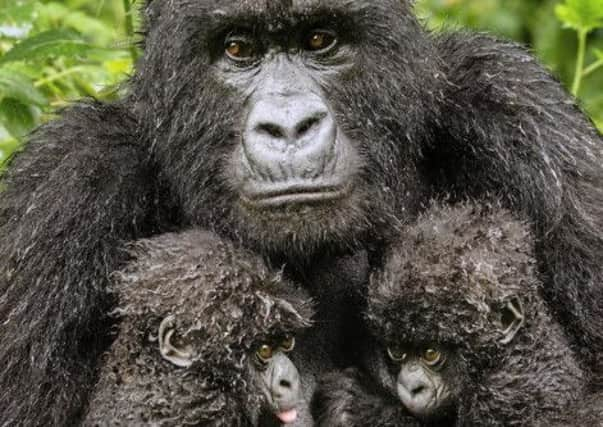Pictures: Wildlife Photo of the Year winners


American photographer Diana Rebman hiked through torrential rain up vertiginous, muddy hills in Rwanda to capture the rare image of the mother with her twin babies, moments after the clash with the male.
“In this picture, she is still tense from the encounter and continues to glance across at him while she eats,” Rebman said. “Her twins, in the comfort of their mother’s strong arms, appear blissfully ignorant.”
Advertisement
Hide AdThe photograph of the mountain gorillas, whose conservation status is listed as “critical” due to threats including poaching and habitat loss, was commended in the contest’s Gerald Durrell Award for Endangered Species.
Rebman is among thousands of international professional and amateur photographers who went to extraordinary lengths to catch the world’s wildlife on camera.
Italian photographer Valter Bernardeschi waded into the icy waters of Russia’s Lake Kuril to capture a spray of crimson roe sent spinning from the body of a pregnant salmon as it is caught by a brown bear.
Bernardeschi’s picture, which was specially commended in the Mammals Behaviour section of the competition, focuses on the largest sockeye salmon spawning ground in Eurasia.
The annual glut attracts Kamchatka brown bears from the surrounding forests to feast on the fish and fatten up for the winter.
And sometimes the best pictures are the most unexpected.
Mexican photographer Alejandro Prieto was out early one morning looking for bull sharks when he suddenly spotted a huge crocodile emerging from the sea with a large green turtle in its mouth.
Advertisement
Hide AdThe image, taken at the Corcovado National Park on the Pacific coast of Costa Rica, was commended in the contest section entitled Behaviour: Cold-blooded Animals.
Other winning entries from almost 43,000 submitted from 96 countries included the unsettling sight of a dugong, or sea cow, surrounded by curious snorkellers.
Advertisement
Hide AdFellow American photographer Douglas Seifert was commended in the World In Our Hands section of the contest for his picture of the rare marine mammal feeding in the sea off Egypt.
Struck more by the sight of tourists bothering the animal until it fled for the open sea, he turned his focus from the dugong to the humans watching it in a bid to raise awareness of the need to control wildlife tourism.
A couple of bedraggled lions pictured by National Geographic photographer Michael Nichols in the Serengeti look understandably fed up, their normally majestic manes plastered to their sodden heads as the rain pours down.
But the soaking is not as unwelcome as their expressions suggest, as water is often scarce and the closely bonded pair lick drops from their own and each other’s fur.
Nichols was commended in the Animals in Their Environment section of the competition, which is now in its 49th year.
The award is run in partnership with BBC Worldwide by the London-based Natural History Museum, which is holding an exhibition of 100 of the winning photographs in October. The show will then tour the UK before being taken overseas.
Images are selected for their “creativity, artistry and technical complexity”.